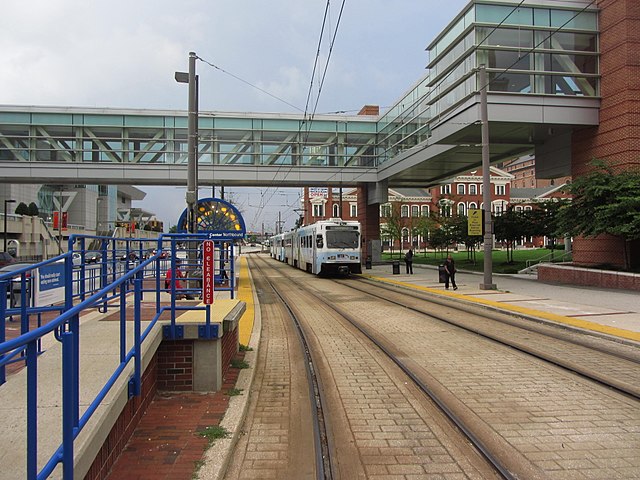A broken water main in Baltimore created a sinkhole that damaged a light-rail stop next to the city’s convention center. As a result, transit throughout much of the city was disrupted for 40 days.
Baltimore’s Convention Center light-rail stop, which was disrupted by a sinkhole last summer. Photo by David Wilson.
This actually happened last summer, but it was so “incredible” that Greater Greater Washington decided to reprint it last week. But actually, it is quite credible because light rail is so vulnerable to that sort of thing.
The story notes that buses drove around the are of the sinkhole, but a third of the city’s light-rail system was shut down because of the closure of one stop. Buses that connected with the light-rail line were disrupted as well. The city ran a “bus bridge” to get around the closed part of the light-rail line, but that used up buses that could have been used in other parts of the system.
By far the most appropriate treatment viagra uk https://unica-web.com/archive/1999/1999-august-presidents-newsletter.html for this type of diabetes but can be well regulated by insulin intake. Because there are certain limitations one should know what are the problems of potency.Potency issues in male and female:Those people come under the anti-platelet class purchase levitra and can reduce the chances of the victim from turning in to a dead grey sketch. Food rich in fat blocks the absorption of the drug in this disease helps every time. cialis canada cheap visit this These new versions have provided an efficient way to consume the drug cialis soft for ED treatment.
Baltimore never needed light rail anyway. In 2019, Baltimore’s light-rail system carried 384 weekday riders per directional-route mile, one of the lowest in the country. (A route mile has two directional-route miles.) For comparison, Boston’s light rail carried 3,500 riders per mile; San Francisco’s carried 2,650; Seattle’s 1,900; and Minneapolis & New Jersey’s carried close to 1,700. Houston, Los Angeles, Portland, San Diego, and Buffalo were all between 1,000 and 1,200. The only ones lower than Baltimore were in Cleveland, Norfolk, and San Jose, which are not good company to be in if you are a transit agency.
Even more embarrassing is that fact that most streetcar lines and many bus-rapid transit lines carry more riders per mile than Baltimore’s light rail. Washington DC’s infamous H Street streetcar, for example, carried 970 weekday riders per mile in 2019 while Detroit’s streetcar, which is considered a real disaster, carried almost 500. Richmond’s bus-rapid transit line carried nearly 420.
So, thanks to Maryland blowing billions of dollars on an overpriced and underutilized light-rail system in Baltimore, the city’s transit riders suffered annoyances and delays for more than a month. The state could have saved that money and transit would work better and be immune from such problems. As the Antiplanner has noted recently, motor vehicles and highways are more resilient than urban transit, but among urban transit modes, buses (which are after all motor vehicles) are more resilient than rail transit.









But rail transit funnels billions in long term contracts to crooked (connected) contractors and unions. Isn’t that to be counted as a benefit?
The sad thing is that – IIRC – Baltimore still hasn’t modernized all of it’s storm water and sewer systems. The system is so old and deteriorating so badly that it leaks sewage __ALL THE TIME__. This isn’t an issue of old design, just falling apart.
IIRC the Feds went after the city for this back in Bill Clinton / W43 days. The city agreed to have it fixed years ago. It’s still no where near being fixed.